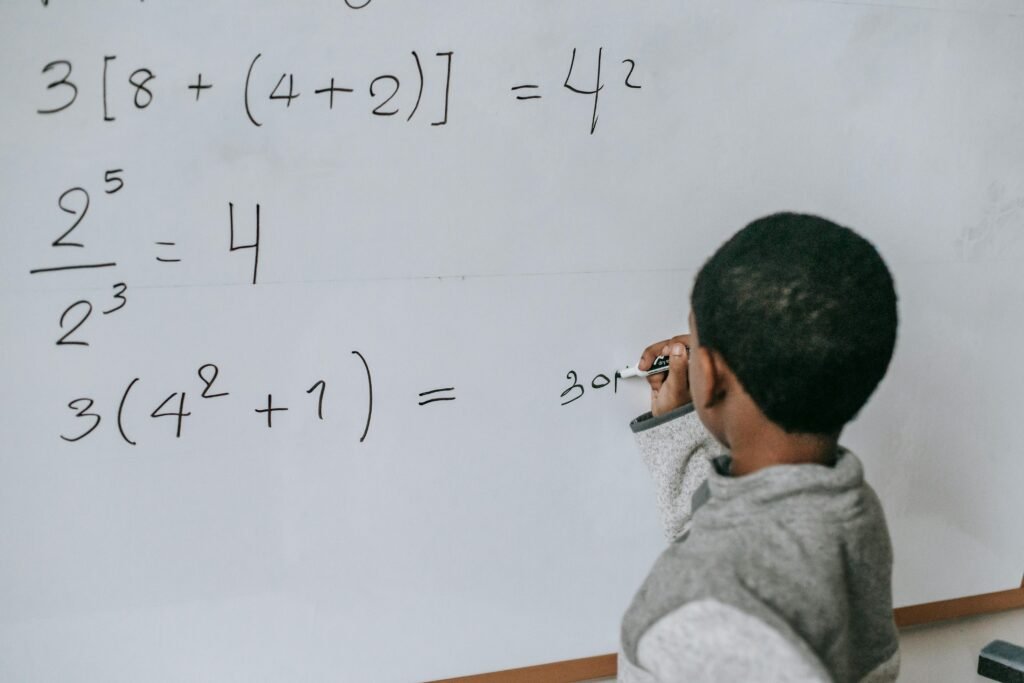It’s hard to stay focused these days. You sit down to study, open your books, and then—ding! A notification pops up. Maybe it’s a message. Maybe it’s a reminder. Maybe it’s just a game update. But whatever it is, it breaks your flow. And getting that focus back? It’s not easy.
1. The average student gets interrupted every 8 minutes while studying
Let’s take a moment to think about this. Every 8 minutes, a student’s concentration is broken. That’s just enough time to get into the rhythm of learning… and then it’s gone. Imagine reading a paragraph, starting to understand it, and then hearing a ping.
A message comes in. The phone lights up. Curiosity kicks in. You glance at the screen, lose your train of thought, and now you have to start over.
Most students don’t even notice this happening. It feels normal. But over time, these small breaks add up to a big problem. If a student studies for an hour, they might get distracted 7 times. That means almost half of their session is spent in and out of focus.
The brain doesn’t like to switch tasks quickly. It works best when it can settle into one thing and stay there. These constant shifts cause mental fatigue. They make it harder to remember what you learn. They also make studying feel frustrating, even if the subject isn’t hard.
Here’s what students and parents can do: First, set a clear study time. Decide ahead of time when and how long you will study. Then, turn off all notifications. Airplane mode is a simple tool that works wonders. If using the internet is required for schoolwork, use tools like website blockers or distraction-free browsers.
You can also try something called the “Pomodoro Technique.” This means studying for 25 minutes straight, then taking a 5-minute break. After four of these rounds, take a longer break. During the study time, absolutely no distractions are allowed. This method trains your brain to focus better and rewards you with short rests.
Over time, students who follow this method find that their ability to focus gets stronger. They finish work faster. They remember more. And they feel more confident.
2. It takes about 23 minutes and 15 seconds to regain deep focus after an interruption
This stat might sound unbelievable at first. Can one small text really cost you 23 minutes of good thinking? The truth is yes. After your brain is pulled away from deep focus, it doesn’t snap back instantly. It needs time to remember what it was doing, to get back into the “flow,” and to rebuild that mental rhythm.
Let’s say you’re working on a math problem. You’re halfway through. Then you get a ping. You check it. Maybe it takes 10 seconds. But when you come back to your math problem, you’ve forgotten where you were. You re-read the steps. You second-guess yourself. You waste time just trying to catch up. And that’s assuming you don’t get another notification soon after.
This isn’t just about phones. It can be a family member calling out. A knock on the door. Even thinking about what’s for dinner. Anything that pulls your mind away breaks the concentration. And that break takes a lot more time to fix than most people think.
So what’s the solution? One way to prevent this is to create a study space that signals “focus time.” That means telling family members not to interrupt. It means putting a sign on the door if needed. It means removing as many distractions from the room as possible—no TV, no open tabs, no noise.
Another powerful tip is to use background noise wisely. Some students focus better with white noise or soft music playing. It creates a wall of sound that blocks out unexpected noises. But be careful: lyrics or loud beats can be distracting too.
Also, remind students to write down where they leave off if they have to stop. A quick note like “Step 3: divide by 4 next” can help them jump back in faster later. This small habit saves a lot of time.
In short, staying focused saves energy. It makes learning easier and faster. Every little interruption adds up—and now we know it can cost nearly 25 minutes of lost focus each time.
3. 80% of students admit to checking their phones at least once every study session
That’s 8 out of 10 students who let their phone sneak into their study time. Why does this matter? Because checking your phone—especially if it becomes a habit—tells your brain that studying isn’t the only thing happening. It splits your attention.
Even one quick check turns into another. You look at a message. Then maybe you reply. Then maybe you scroll a little. Before you know it, 10 minutes are gone. And your brain? It’s no longer in study mode. It’s in scroll mode.
When this becomes a regular habit, students start to associate study time with distraction time. Their brain never fully enters “focus mode,” and the quality of their learning drops.
The solution? Make the phone “out of sight, out of mind.” Don’t just put it on silent. Put it in a drawer. Another room. Somewhere far away. Some students even give their phone to a parent during study time. It may sound extreme, but for many, it works.
Another idea is to use the phone as a reward. Set a timer for 30 minutes of pure study. No peeking. Then give yourself 5 minutes of phone time. You’re turning the phone into something earned, not something that steals your attention whenever it wants.
It’s also helpful to track habits. There are apps that tell you how many times you unlock your phone. Seeing that number can be a wake-up call. When students notice they checked their phone 50 times in a day, they start to take action.
Helping students become aware of how often they reach for their phone is step one. Step two is building a better habit. And step three? Watching their confidence and focus grow.
4. 65% of study time is spent on non-academic activities when phones are nearby
That’s a shocking number. More than half the time a student plans to study is actually spent doing other things—because their phone is nearby.
Think about it. A student sits down with the best intentions. Books open. Notes ready. But their phone is right next to them. It buzzes. They check it. Then they scroll. Then they remember a video they wanted to watch. Then maybe they look at something funny and send it to a friend. Before they know it, the clock has ticked by, and very little real studying has happened.
The scary part is that many students don’t even realize it’s happening. They feel like they’ve been studying for hours. But when asked what they’ve learned or finished, there’s not much to show.
The fix here is simple, but powerful. Remove the phone. Yes, again. It’s that important. But also, make a clear plan for each study session. Don’t just “study science.” Instead, say, “I will finish reading Chapter 3 and answer all 10 questions at the end.” When there’s a goal, it’s easier to stay on track.

Set a timer. Watch the clock. Challenge yourself to beat the clock without any distractions. Turn it into a game. When students do this, their focus sharpens and they start to enjoy the feeling of finishing work without delays.
It also helps to reflect afterward. Ask: “Did I use my time well today?” and “What distracted me?” Over time, these tiny questions build powerful habits that keep students in control of their time and their brain.
5. Notifications reduce student performance by up to 20%
This is huge. A 20% drop in performance just because of notifications. That could mean a full letter grade lower. Or missing key points on a test. It’s like trying to study while someone whispers in your ear the whole time. You can’t give your full attention to the task.
What’s worse is that students often feel like they’re doing okay. They think, “I’m managing. I’m good at multitasking.” But the brain isn’t built to do two thinking tasks at once. It switches quickly between them—and that switch costs time and accuracy.
So what should students do? The first step is turning off all push notifications. Go into each app’s settings and shut them off. Keep only the ones you truly need—like for emergencies or family. Everything else can wait.
Use “Do Not Disturb” or “Focus Mode” on the phone. These features are designed to block all alerts for a set time. If it’s hard to trust yourself, use an app like Forest or Focus Lock that blocks apps and tracks your focus time.
Also, remind students why they’re studying. Not just for a grade—but to learn something new. To grow smarter. To build their future. That mindset helps keep distractions in their place. They’re not the enemy—but they do need limits.
6. 90% of students say phone notifications distract them during homework or studying
That’s almost every student. It doesn’t matter how disciplined or smart they are—90% say notifications get in the way. This tells us something important: it’s not a personal weakness. It’s a design problem.
Notifications are built to grab attention. They use sound, color, and movement to pull your eyes away. And they work. Even if you don’t check your phone, the buzz or ding plants a seed of curiosity in your mind. “Who was that? What’s happening?” The brain shifts from study mode to wondering mode.
And just like that, focus is broken.
The good news? There’s a simple fix—but it needs to be done with purpose. Students can go into their phone settings and change their notification style. No sound. No banners. No vibrations. Just silent alerts that stay out of sight until break time.
Better yet, students can take a moment before studying to put their phone in full silent mode or enable “Focus Mode.” Many smartphones now have this built-in, allowing only urgent calls or specific contacts to get through.
For younger students, parents can help set these rules. Create a habit of checking phones only before and after study time. Make it part of the routine, like brushing teeth or packing your school bag.
Also, build awareness. Ask your child how often they hear a notification when they’re studying. You might be surprised at how much they notice once they start paying attention. That awareness is the first step in taking control.
When kids understand that nearly all students struggle with this—and that it’s not a personal failure—they become more open to trying new ways to study smarter.
7. Students who turn off notifications improve study efficiency by 25%
That’s a big jump. A full 25% more work done in the same amount of time. That’s like turning a 60-minute study session into 75 minutes of focus, just by hitting one button.
Think about what this means for busy students. They can study for less time but get more done. That means more free time, better rest, and less stress. Or they can keep their study time the same and go deeper into their subjects. Either way, it’s a win.
Turning off notifications is one of the easiest, most effective study tools out there—and it’s free.
Here’s how students can make the most of it. Set up a “focus profile” on your device. This might be called “Do Not Disturb,” “Study Mode,” or something similar depending on your phone. In this mode, only the most important calls get through. Everything else waits quietly.
Then, set a specific amount of time for deep work. It might be 30 minutes, 45 minutes, or an hour. During that time, no peeking at the phone. When the time is up, take a break, check your messages if needed, and then go again.
Over time, this habit builds strong focus muscles. Students begin to enjoy the feeling of full concentration. They remember more, solve problems faster, and feel proud of their work.
Parents can support this by praising effort over results. If your child turned off their phone and studied with full focus, celebrate that—even if they didn’t get everything perfect. The habit matters more than the homework.
Students who take control of their attention don’t just do better in school. They also build a skill that will help them for life.
8. Just hearing a notification sound—even without checking it—can drop focus by 10%
You don’t even have to look at your phone. Just hearing a buzz or ping can shake your focus enough to lower your performance by 10%. That’s like missing a key point in a lesson, making an error in a math problem, or losing the flow of a writing assignment.
The reason is simple. The brain is wired to pay attention to new sounds. It’s a survival instinct. When something makes a noise, the brain assumes it might be important. So even if you don’t touch the phone, your thoughts drift.
“What was that? Is it urgent? Should I check it?”
You’re no longer thinking about your schoolwork. And even if it’s just a few seconds of distraction, the brain takes time to get back on track.
What can you do about this? The answer is physical distance. Don’t just silence your phone—move it away. Put it in another room, in your backpack, or in a drawer. That way, even if it makes a sound by accident, you won’t hear it.
Another trick is to use noise-canceling headphones or white noise apps. These block out the little background sounds that often pull us away. For students in busy homes, this can be a game-changer.
Also, try sound training. Let your brain get used to silence. Many students say they need background noise to focus, but often that’s because they haven’t tried real silence in a long time. Give it a week. Study in a quiet space, no music, no alerts. Many students find their mind relaxes and focus gets easier.
Sometimes, doing less is the secret to learning more. In this case, turning off the sounds—even the tiny ones—can boost brain power and study success.
9. Multitasking with social media lowers academic performance by up to 40%
Yes, 40%. That’s nearly half. It’s one of the most serious stats on this list. Social media may seem harmless, but when it creeps into study time, it creates chaos in the brain.
Students who try to study while checking messages, watching short videos, or scrolling through posts are forcing their brain to split in two. One half tries to focus on the task. The other half wants to enjoy the scroll. And the result? Neither job gets done well.
Studies show that switching between apps and study tasks not only wastes time—it also lowers memory, reduces understanding, and makes learning feel harder.
So what can students do instead? The answer isn’t “quit social media.” That’s not realistic. But they can create a time and place for it. The rule is simple: “No social media during study.” That includes breaks between problems or quick scrolls while waiting for a file to load.
Instead, students can use social media as a reward. Finish your study goal, then take a short break to check your feed. Use a timer to keep the break short. Then return to your work refreshed.
Apps like Freedom, StayFocusd, and AppBlock can help. They block access to distracting apps during study time. This removes the temptation and builds better habits.
Parents can also help by creating “no scroll” zones during homework time. Set up one hour each day when the house is quiet and phone-free. Make it a shared effort.
Once students feel the difference—how much faster and easier learning becomes without social media—they often choose to stay focused by themselves.
10. College students check their phones an average of 11 times per study hour
That’s almost once every five minutes. These are older students, often working on complex topics, and still the phone pulls them in again and again. It shows how strong the habit is—and how normal it has become.
But each time they check their phone, even for a few seconds, they lose the thread of what they were doing. They have to re-read, re-think, or restart. Over time, this slows down progress and creates frustration.
So how can students beat this habit?
One trick is to create a visible study log. Write down the time you start, and every time you reach for your phone, make a mark. This shows you, in real time, how often it happens. Just being aware is powerful.
Then, set small goals. “I’ll go 10 minutes without checking.” Then 20. Then 30. Build the habit slowly. Praise yourself for progress, not perfection.
Some students like to use the “two-device” method. One device for study. One for distractions. They keep the distraction device away, and only allow themselves to use it after they’ve hit a study milestone. It makes the reward feel earned.
The goal is not to create shame. It’s to build skills. Every student can train their brain to focus better. And the best way to start is by noticing what pulls their attention—and choosing to take that power back
11. Teens receive an average of 237 smartphone notifications per day
Two hundred thirty-seven. That’s not a typo. It’s a flood. And each one is an open door for distraction. A typical teenager doesn’t even realize it, but their phone is buzzing, pinging, or lighting up nearly 10 times every hour they’re awake. That’s more often than most people blink!
What do these notifications include? Messages from friends, updates from apps, game invites, breaking news, ads, reminders, emails—and the list goes on. Each one steals a tiny bit of focus. Some only last a second, but others pull kids into long conversations or social rabbit holes.
Now imagine trying to study with this going on in the background. It’s like trying to read a book at a rock concert.
Here’s the key: not every notification matters. In fact, most don’t. But students rarely take the time to sort out what’s urgent from what’s noise. And over time, this constant stream trains the brain to expect interruption. That’s when deep focus becomes nearly impossible.
So what’s the solution? Students should sit down with their phones and go through their notification settings one app at a time. Ask: Do I need this alert? Can it wait? If the answer isn’t “yes, right now,” then turn it off.
Social apps, in particular, love to send fake “important” notifications. Things like “Your friend posted a new story” or “You have a memory from two years ago.” These are designed to create FOMO, not help you.
Another smart strategy is to batch-check messages. Instead of checking every few minutes, students can set times when they’ll respond—like after a study block, during lunch, or in the evening. This builds healthy control over attention.

Parents can support this by modeling the same behavior. Keep phones away during family meals or quiet time. Show kids that not every ping deserves a response.
Reducing the number of notifications a teen sees in a day is like clearing clutter off a desk. It makes room for real learning—and peace of mind. And that’s worth far more than any emoji-filled message.
12. 62% of students feel anxious if they don’t check a notification immediately
This is more than just a distraction—it’s an emotional pull. When 62% of students say they feel anxious if they don’t check a notification right away, it shows how deeply tied our emotions have become to our phones.
This feeling is called “notification anxiety.” It’s a mix of curiosity, fear of missing out (FOMO), and the need to stay “connected.” But when this becomes a regular habit, it creates a cycle. A notification comes in, the student feels nervous, they check it, they feel better—for a moment. But then it happens again. And again.
This constant anxiety damages focus. Even when there are no notifications, the brain is still half-watching the phone, waiting for the next ping. It’s like trying to study while expecting a tap on the shoulder at any moment.
Breaking this pattern takes small, steady steps. First, students need to learn that it’s okay not to respond immediately. Nothing bad happens. The world keeps turning. This takes practice.
Try this exercise: During study time, turn off notifications for just 15 minutes. No checking, no peeking. After the timer goes off, let the student check everything. Most of the time, nothing urgent has happened. That experience begins to ease the anxiety.
Slowly increase the timer over days—20 minutes, 30, even an hour. Each session proves to the brain that it’s safe to focus.
Another helpful idea is to change how notifications appear. Switch from banners and pop-ups to silent delivery. This way, the phone still collects alerts, but doesn’t show them in real time. It helps build trust that everything is still there, just not in the way.
For students who feel especially anxious, journaling helps too. Ask them to write down what they think they’re missing when they don’t check. Often, the fear is bigger than the reality. Writing it out helps shrink it.
Learning to delay checking messages is more than a study tip—it’s a life skill. It teaches patience, emotional control, and self-confidence. And once that anxiety goes down, students find it much easier to dive deep into learning.
13. Students studying with their phone in sight score 10% lower on tests
This one is surprising—and a little scary. Just having a phone visible while studying, even if it’s not being used, can lead to test scores that are 10% lower. That’s not even about using the phone. It’s about its presence.
Why does this happen? It’s called “brain drain.” The phone acts as a visual reminder of distraction. Your brain knows it’s there. Even if you’re not using it, part of your attention stays tied to it. It’s a mental tug-of-war, and studying loses.
That’s why a simple trick like putting the phone out of sight can make such a big difference. Out of sight, out of mind—it really works. When the phone is in a drawer, bag, or another room, the brain relaxes. It can give full power to the task at hand.
The solution is simple but needs to become a habit. Before starting any study session, make it a rule: the phone goes out of sight. Not upside down on the desk. Not in your lap. Away.
For extra motivation, students can test this for themselves. Study for one week with the phone in sight. Then one week with the phone completely out of reach. Then compare grades, notes, or just how focused they felt. The results are often eye-opening.
Parents can also help by creating a “study zone” at home. A clean desk, good light, quiet space—and no devices in the area unless needed for the work. It becomes a signal to the brain: this is a place for deep work.
The brain loves focus. It does its best work when there’s nothing else pulling at it. Removing even the silent presence of a phone gives students an edge—and helps unlock their full potential.
14. 48% of students use apps that block notifications to help them focus
Nearly half of all students already use technology to fight back against distractions. That’s a good sign. It means kids are becoming aware of the problem and looking for tools to solve it.
Apps like Forest, Freedom, Cold Turkey, and AppBlock are just a few of the tools out there. They work in different ways—some block specific apps, others block all access to the internet, and some even reward students for staying focused.
Forest, for example, grows a little tree on your screen when you stay off your phone. If you leave the app, the tree dies. It sounds simple, but it’s surprisingly effective—and it makes staying focused feel like a game.
Using these tools gives students back control. They set the rules, and the app helps enforce them. It’s not about punishment. It’s about support. For students who struggle with self-control, these apps act like training wheels. They help build stronger focus over time.
To get started, pick one app. Try it during just one study session a day. Set it for 30 minutes, then take a short break. See how it feels. If it helps, make it a daily habit.
Some apps even track how much time you’ve spent focused. Watching that number grow is motivating. It shows progress in a way grades don’t always do.
Parents can support this by asking questions like, “How did your focus app work today?” or “Want to show me your forest?” Turning the conversation into something fun and positive keeps motivation high.
Technology got us into this mess, but it can also help us out. When students use tools that block distractions, they build healthier habits—and learn how to work smarter, not harder.
15. The average attention span of a student has dropped from 12 seconds (2000) to 8 seconds (recent years)
This one hits hard. In just a couple of decades, the average attention span has dropped by one-third. From 12 seconds to 8. That’s even shorter than a goldfish, if you believe the jokes.
But the point is serious. Students today are growing up in a world of fast content, quick swipes, and constant alerts. Their brains are being trained to jump, not to stay. And that’s a problem when it comes to studying, which requires long, quiet, focused thinking.
What’s causing this drop? It’s not just phones. It’s how we use them. Short videos, instant replies, constant scrolling—these habits teach the brain that if something doesn’t grab you instantly, you move on.
But studying isn’t like that. Learning something deep—like algebra, or biology, or how to code—takes time. It’s not flashy. It doesn’t offer a reward every few seconds. That’s why students now find it harder to sit with hard work.
The good news? Attention span is like a muscle. It can be trained. One great method is the “Focus Ladder.” Start by focusing for just 5 minutes. No distractions. Then rest. Then try 10. Then 15. Climb the ladder slowly, day by day. In time, students learn to focus for longer without feeling tired or bored.
Another tip is reading. Real books. No screens, no swipes. Reading builds patience. It stretches the attention span. Even 10 minutes of daily reading can help.
And don’t forget mindfulness. Just sitting still and breathing for one minute helps the brain calm down. It teaches students how to manage their own attention—something even many adults haven’t learned.
We can’t go back to 12-second attention spans overnight. But with practice, and the right tools, every student can learn to stay focused longer. And that opens the door to better learning—and more success.
16. 71% of students admit to checking notifications even during online lessons
This one’s a big red flag. When students are in online classes, you’d expect full attention. After all, they’re already on the device—watching, listening, and (hopefully) learning. But the truth is, 71% of students are still checking notifications even while the lesson is happening.
It’s easy to understand why. The same device they use for school is also where they chat with friends, play games, and scroll social media. There’s no physical divide, so their brain slips between “class” and “fun” without even noticing.
But here’s the issue—every time a student checks a notification during a lesson, they miss something important. A new concept, a teacher’s explanation, a key example. Even if it’s just for a few seconds, that gap makes learning harder later.
This is especially dangerous with subjects like math and science, where each new idea builds on the last. Miss one step, and the whole thing can fall apart.
To fight this, students need structure. Start by using “full screen” mode during classes. This blocks out the taskbar, notifications, and anything else that can grab attention. Most video platforms allow this with one click.
Next, turn off all non-class notifications before the session starts. Use “Do Not Disturb” or “Focus Mode.” Even better, use a second device for communication (like a tablet or home phone), and keep the main study device clear.

For younger students, parents can help by checking the screen setup before class begins. Sit nearby for a few lessons and gently guide them back if their attention drifts. This isn’t about policing—it’s about building habits.
Teachers can help too. Short breaks every 20–30 minutes give students a chance to check messages and then refocus. The goal isn’t zero notifications forever—it’s to keep them outside of learning time.
Over time, students will begin to notice something powerful: when they give class 100% of their attention, they actually get it. They understand faster. They need to review less. And that good feeling becomes its own reward.
17. Students lose up to 2.5 hours of productive time daily due to distractions
That’s a full movie. That’s the time it takes to study two subjects deeply. That’s 2.5 hours every single day lost—not to sleep, not to breaks, but to distractions.
And most students don’t even realize it’s happening.
Here’s what usually goes on: a student starts studying. Five minutes in, they check their phone. Then maybe a YouTube video pops up. Then a friend sends a funny clip. Suddenly it’s 40 minutes later, and the page is still blank. That pattern repeats through the day.
The small moments add up. A few seconds here, two minutes there, and by bedtime, they’ve lost hours they thought they were using well.
This is one reason why students feel like they’re working “all day” but still not finishing anything. It’s not laziness—it’s leaks in their time bucket.
The solution is to take control of where that time goes. The first step? Measure it. Apps like RescueTime or Moment can show how much time is actually spent on different tasks each day. Seeing the numbers is often a wake-up call.
Next, use time blocks. Plan the day in chunks: 45 minutes for homework, 10-minute break. 30 minutes for reading. 15 minutes for review. During each block, no switching tasks. Just one job at a time.
For younger learners, even setting a kitchen timer works well. It builds a rhythm: focus, rest, repeat.
And here’s the best part: when distractions are reduced, students often get the same work done in half the time. That means more freedom, more rest, and more fun.
Parents can help by building this into the family schedule. Set “quiet hours” when everyone is focused. No TV. No phones. Just peaceful work time. Make it a shared challenge. Celebrate when the student finishes early—because they focused, not just because they “tried.”
Two and a half hours is a lot to lose. But once students know how to protect that time, their whole day starts to feel easier—and way more productive.
18. 89% of students report procrastination due to notification-induced distractions
Procrastination doesn’t always look like laziness. Sometimes, it’s caused by noise—the kind of noise that lives in our pockets and beeps every five minutes.
When 89% of students say they procrastinate because of notifications, they’re telling us something very clear: distractions don’t just slow them down—they make it harder to start.
Here’s how it happens: A student sits down to study. The phone lights up. They check it. Then they scroll. Now their brain isn’t in study mode anymore. They feel less motivated. They tell themselves they’ll start in five minutes… and then don’t. It becomes a loop.
Notifications feed that loop. They give your brain little hits of reward—likes, messages, laughter—and make real work feel boring by comparison.
So, what’s the fix? Step one is simple: start without your phone. Even if it’s just for five minutes. Tell yourself, “I’ll study for five minutes and then I can check.” Once you start, it’s often easier to keep going.
Step two is to prepare your space. Remove clutter, silence notifications, and get everything you need before you begin. Fewer reasons to get up means fewer chances to lose momentum.
Step three? Break big tasks into tiny ones. Don’t say, “Write essay.” Say, “Write the first sentence.” That small action helps push past procrastination.
Students also benefit from “if-then” planning. It works like this: If I feel the urge to check my phone, then I’ll write one more sentence first. These small promises trick the brain into action.
Parents can encourage this by asking, “What’s the tiniest part of your assignment you could do right now?” That question shifts the student’s thinking from “later” to “now.”
Procrastination isn’t about willpower. It’s about habits. When students control notifications, they remove one of the biggest blockers. And once they get started, their brain does the rest.
19. Push notifications are responsible for over 50% of all smartphone interruptions
Push notifications are sneaky. They’re the ones that show up on your lock screen. The ones you didn’t ask for. The ones that apps send just to get your attention—whether it’s needed or not.
And they’re responsible for more than half of all interruptions.
This means that just disabling push notifications could cut distractions in half. That’s huge.
The problem is, most apps turn them on by default. And many students never change the settings. They get notifications for app updates, ads, streaks, and game rewards—none of which are important during study time.
Here’s the fix: Students (and parents) should go into their phone settings and review notifications app by app. Turn off anything that isn’t urgent or useful. This includes shopping apps, games, and even social media alerts.
Some phones have a “notification summary” feature. It collects notifications and delivers them all at once, at a time you choose. This prevents random pings from breaking your focus every few minutes.
Another smart strategy is to uninstall apps that send too many push alerts. If it’s not adding value, it’s just adding noise.
Think of your phone like your backpack. You wouldn’t carry a noisy toy that kept going off during class. So why allow your phone to do the same?
Once students take control of push notifications, they feel more in charge of their day. Their mind is quieter. They’re not constantly pulled in different directions.
And what’s left? Just learning, thinking, and growing—with less noise, and way more calm.
20. 76% of students who used distraction-limiting apps saw improvement in grades
Here’s some good news. When students do take steps to limit their distractions—like using focus apps—their efforts pay off. In fact, 76% of them saw better grades. That’s nearly 3 out of 4.
This tells us that focus isn’t just about feeling good. It’s directly tied to results.
When the brain isn’t split between studying and social media, it can process information more clearly. Students finish work faster, make fewer mistakes, and understand more deeply. Over time, that leads to higher test scores, stronger assignments, and better overall performance.
But more importantly, students feel smarter. They don’t second-guess themselves as much. They don’t have to re-read the same page three times. And that builds confidence.
Focus apps come in all styles. Some block certain websites. Others use timers. Some even grow virtual plants or show stats about your day. The key isn’t which app you use—it’s that you use one at all.
Start small. One study session a day. Use the app to block distractions for just 25 minutes. Then take a short break. Over time, increase the length.
Students can track how they feel after each session. Was it easier? Did they get more done? These small wins motivate them to keep going.
Parents can encourage this too. Celebrate focus time more than grades. Praise the habit, not just the outcome.
Grades go up when distractions go down. It’s that simple. And with the right tools, every student can make that happen.
21. Digital distractions account for 31% of all time lost in study sessions
When students sit down to study, they often don’t realize how much of that time slips away to distractions. According to this stat, almost one-third of study time is lost to digital interruptions. That’s a big chunk. It means that if a student studies for 3 hours, about an entire hour is wasted on things like phone checks, app scrolling, or bouncing between tabs.
And it’s not always on purpose. Sometimes students don’t even notice they’ve been distracted. A quick message reply turns into a five-minute chat. A look at the clock becomes a scroll through notifications. A “quick break” to watch a video turns into three more videos. Before they know it, time has vanished—and so has their focus.

The challenge is that students feel like they’ve been working the whole time. But their brain wasn’t fully engaged. So even after a long session, they don’t feel confident about what they learned.
The solution starts with awareness. Students should start timing their study sessions and tracking actual focus time. Use a timer or an app that shows “deep focus” minutes. Many are surprised when they see how little of their study time was actually productive.
Next, create a distraction-free routine. Before studying, put the phone in another room. Close unused tabs. Tell friends not to expect replies during study blocks. Use site-blockers if needed to stay off tempting websites.
Also, try studying in smaller bursts with total focus. It’s better to have 30 minutes of true concentration than 2 hours of half-distracted effort. When students realize how much more they can get done in less time, they feel empowered.
Parents can support by encouraging quality over quantity. Instead of asking, “How long did you study?” ask, “Did you stay focused while studying?” That shifts the goal from sitting with a book open to actually learning.
Once students take back that 31% of lost time, they’ll see the difference—not just in their grades, but in their confidence too.
22. Students interrupted during studying score 14% lower on recall tests
This stat shows just how serious interruptions can be. If a student is studying and gets interrupted—even briefly—they remember 14% less of what they studied. That’s a big drop. In real terms, that could mean missing important facts on a test, forgetting key formulas, or struggling to explain what they just learned.
Why does this happen? Because memory needs focus. When your brain is interrupted, it doesn’t get a chance to fully store what you were learning. It’s like trying to write a message in sand while the wind keeps blowing it away. You keep starting, but it doesn’t stick.
Even small distractions—like checking a message or glancing at a screen—break this mental process. Your brain shifts away from “learning mode” and into “reaction mode,” and that shift makes it harder to remember things later.
To protect memory and recall, students need to create what’s called a “distraction-free learning zone.” This could be a desk in their room, a quiet corner of the house, or even a spot in the library. The key is that this space sends a signal: This is where I focus.
During study time, phones go away. Doors stay closed. Background noise is low or consistent. If music helps, it should be calm and instrumental—nothing with lyrics that might compete for attention.
Another strategy is to study in chunks, then test yourself. After 20 or 30 minutes, close the book and try to recall what you just learned. Say it out loud or write it down. This not only strengthens memory but also makes distractions feel more disruptive—because you’ll notice how much they affect your ability to recall.
Parents can encourage this by keeping household noise low during study times and setting family “quiet hours” when everyone focuses on their own tasks. It builds a supportive environment that helps everyone think clearly.
When students protect their brain from interruptions, they remember more—and remembering more leads to better learning and better results.
23. Social media alerts cause a 27% drop in comprehension during reading
Reading is already a challenge for many students. It takes patience, attention, and a steady mind. Now imagine trying to read while getting social media alerts. It’s like trying to listen to a story while someone whispers in your ear the whole time. No wonder comprehension drops by 27% when social alerts are involved.
Here’s why. Reading requires your brain to paint a picture. You connect words, build ideas, and imagine what’s happening. But when a message pops up—especially a social one—it breaks the flow.
Your brain has to switch gears. Even if you don’t open the message, the thought stays with you. “What was that about? Should I check it later?” And just like that, the sentence you were reading gets lost.
Many students say they re-read the same paragraph over and over. That’s often because of alerts interrupting their focus. It doesn’t mean they’re bad readers—it means their attention is being stolen.
The fix? When it’s reading time, go “silent mode.” That means all social apps are off. No buzzing, no banners, no badges. For many students, this one step alone makes a huge difference.
Another tip is to use real books instead of digital copies when possible. Physical books don’t buzz or pop up with messages. They help create a full reading experience without tech noise.
For digital reading, use distraction-free apps or settings. Many e-readers and reading apps have focus modes that hide all extras and give you just the words on a clean background.
Students can also use a reading log. After each page or chapter, write down one sentence about what you understood. This keeps the brain focused and builds comprehension.
Parents can encourage reading time by modeling it themselves. Set aside 20 minutes a day for everyone in the house to read quietly. Make it part of the daily rhythm. No phones allowed. Just pages.
When reading comprehension goes up, so does confidence. Students stop feeling “stuck” in texts and start feeling smart. And that all starts with turning off the noise.
24. 69% of students say group chats are a major distraction while studying
Group chats are fun. They’re fast, funny, and keep students feeling connected. But during study time, they can be a total trap. In fact, 69% of students say group chats regularly distract them from learning.
Here’s why they’re so hard to resist. Group chats don’t just send one message—they send many. It’s often a stream of comments, jokes, memes, questions, and reactions. Even if a student plans to “just check one thing,” they end up getting pulled into the chat vortex.
And because these chats are usually with friends or classmates, students feel pressure to respond quickly. They don’t want to seem rude or left out. So they reply. Then another message comes in. And another. Before they know it, 20 minutes have gone by—and they forgot what they were studying.
So what’s the fix?
First, students should be honest with themselves about when they’re most distracted. If it’s during group chat hours, that’s a signal to make a change.
One option is to mute the chat temporarily. Most messaging apps have a “mute for 1 hour” or “mute until tomorrow” feature. Use it.
Another strategy is to create a separate chat with one study buddy instead of the whole group. This way, students can ask questions without getting pulled into side conversations.
Or better yet—turn group chats into a reward. “Once I finish my homework, I’ll check the group.” That simple boundary helps protect focus and gives students something fun to look forward to.
Parents can help by creating tech-free homework time at home. Make it a rule that group chats stay silent until study time is over.
Students don’t need to leave their groups or stop chatting with friends. They just need to learn when to put the group on pause—so their own goals come first.
25. Only 11% of students can go an entire hour of studying without a digital interruption
This stat is perhaps the most telling. Out of 100 students, only 11 can study for one full hour without being interrupted by some form of digital noise. That means nearly everybody else is getting pulled away before they even finish a single focused hour.
This paints a clear picture: uninterrupted focus is rare—but it doesn’t have to be.
The modern world is noisy. Notifications, reminders, messages, and content are always a tap away. But students don’t have to give in to every alert. With the right habits, they can learn to hold their attention longer—and feel proud of it.
One approach is to build up to an hour slowly. Start with 10 or 15 minutes of uninterrupted focus. Then pause, take a short break, and go again. With each round, stretch it a little longer. This trains the brain to stay engaged.
Another strategy is to create a visible goal. Write down what you want to achieve during that hour. Not just “study,” but “finish math worksheet” or “read Chapter 4.” Having a clear target makes it easier to stay on track.

To support this, use a visual timer. Tools like Time Timer or even a simple kitchen timer help you see the time passing—and stay focused until it’s done.
Parents can support by joining in. Set an hour where everyone in the house works quietly. Phones go in a basket, background noise goes off, and it becomes a shared moment of deep focus.
That one hour of quiet, focused effort can change everything. It helps students get more done, feel more confident, and discover what their brain is really capable of—when it’s not being pulled in every direction.
26. Phone vibrations alone can disrupt short-term memory tasks by 18%
This one surprises a lot of people. Even when a student doesn’t check their phone, just the vibration can mess with their ability to remember things. In fact, short-term memory tasks drop by 18% when a phone buzzes nearby.
Here’s what’s happening: the brain is like a flashlight—it shines brightest when it’s pointed at one thing. But every buzz pulls that light away, even for a second. The brain goes from storing information to wondering, “Was that important?” And during that shift, small details slip away.
This is especially harmful during tasks like memorizing vocabulary, learning math steps, or reading for meaning. These tasks require your brain to hold information for a short time, work with it, and then save it for later. If your attention gets interrupted mid-step, the whole process breaks down.
To prevent this, students can start by turning off vibrations during any study time. That includes both the “buzz” for calls and the gentle “tap” for notifications. Most phones have settings to disable these without completely muting the device.
But the best step? Put the phone out of reach. Not in a pocket, not on the desk, not even face-down nearby. Put it in another room, in a drawer, or give it to a parent. When it’s physically far away, the brain can fully relax into the task.
Another trick: tell close friends or family when you’re studying. That way, they know not to message you—and you don’t feel like you’re missing something important.
Students can even reward themselves after a focused session by checking their phone. That makes focus something to look forward to—not something that feels like punishment.
Short-term memory is like a muscle. The more we protect it, the stronger it gets. And the less buzzing in the background, the better our brains can work.
27. More than 50% of students feel mentally fatigued after frequent interruptions
Ever feel drained after studying, even when you didn’t study that hard? That’s not just mental effort—it’s mental recovery. When your brain is constantly pulled in and out of focus, it gets tired fast. That’s why over half of students say they feel worn out after a session full of distractions.
Interruptions don’t just waste time. They burn brain energy. Imagine trying to solve a puzzle, but someone keeps shaking the table. Every time you try to concentrate, you lose your place. That stop-start pattern wears you out.
What does this lead to? Low motivation. Frustration. Even the feeling of “I’m just not good at this.” But it’s not a problem with the student—it’s a problem with the environment.
The fix is to build momentum instead of breaking it. That means setting up study time with the goal of fewer interruptions, not longer hours. A short session of pure focus is often more powerful than hours of scattered effort.
Here’s a good routine: set a timer for 25 minutes. Study with full focus. No phone, no talking, no hopping between apps. When the timer ends, take a real break. Stand up, stretch, get some water. Then go again.
This helps the brain stay sharp without burning out.
Also, limit the number of things you’re trying to do at once. Don’t switch between subjects every 5 minutes. Stick to one task until it’s done or until your focus naturally fades. This helps your brain stay in one lane instead of zig-zagging all over the place.
Parents can help by checking in after a study session—not just with “What did you learn?” but “How did that feel?” If your child says they’re exhausted every time, it might be time to change the way they study, not just the amount.
When we protect the brain from too many jolts, it rewards us with energy, clarity, and peace.
28. Students who keep phones out of reach finish tasks 30% faster
That’s a huge time saver. Imagine finishing your homework in 30% less time—just because your phone isn’t nearby. No extra tutoring. No fancy hacks. Just moving the phone out of arm’s reach.
Why does this work? Because the brain loves rhythm. When it stays focused, it enters a flow state—where things feel smooth, even fun. But the second a phone is nearby, the brain is on alert. Even if it’s quiet. Even if you don’t touch it. Your attention is divided.
Keeping the phone out of reach is like taking off a heavy backpack. Your brain moves faster, with less stress.
Try this: before each study session, do a “focus setup.” Get your books, notes, and tools. Then place your phone far away. Not in your pocket. Not upside down next to you. In another room, or on a high shelf.
Start the timer. Work with full attention. You’ll likely find that things go quicker, and you feel better afterward.
Students often say, “But I use my phone for studying.” That’s okay—just set limits. If you need it for research, use a separate device like a school laptop. Or use the phone with apps that block everything else during study time.
Parents can encourage this by setting family phone-free blocks. Make it a challenge. “Let’s all go one hour with phones away!” It becomes a game, not a punishment.
When students see how much quicker they can get things done, they often want to study this way. Because finishing early means more time for rest, hobbies, and fun.
Time is one of the most valuable things a student has. And moving the phone away gives them a big chunk of that time back.
29. 43% of students have had to re-read material due to lost focus from a notification
Almost half of all students say they’ve had to read something twice—or even three times—because of a distraction. A notification comes in, they look away, and by the time they look back, they’ve forgotten what they just read.
This leads to frustration. “Why can’t I focus?” “Why does this feel so hard?” But it’s not the student’s ability that’s the problem—it’s the constant interruptions pulling them away from the material.
Reading—especially for understanding—needs your full brain. You’re not just looking at words. You’re making connections, asking questions, and picturing what’s happening. That deep thinking gets disrupted the moment your attention is split.
Here’s a helpful fix: before reading, take one minute to set your space. Remove all distractions. That includes silencing your phone, clearing your desk, and telling anyone nearby, “I need quiet time.” Then read in chunks—maybe 1 page, or 5 minutes—then pause. Close your eyes and ask yourself, “What did I just read?”
If you can answer in your own words, you’re focused. If not, you might need to re-read. That’s okay. It’s part of learning. But over time, this habit trains your brain to notice when it’s zoning out—and pull itself back faster.
Another tool is annotation. While reading, underline key words. Write questions in the margin. This keeps your brain active and connected to the page.
For students who really struggle, try reading aloud. Hearing the words helps some learners stay engaged. Or use a finger to follow the line—you’d be surprised how much that simple trick helps you stay present.
The goal is to read once—and remember it. And the fewer distractions around, the easier that becomes.
30. 86% of students believe they would perform better academically if they had fewer digital distractions
This last stat says it all. Almost nine out of ten students believe that if they could just cut back on digital distractions, they would do better in school. That means they know the problem—and they want to fix it.
That’s powerful.
It means students aren’t lazy. They’re not clueless. They’re just overwhelmed by a world that constantly pulls at their attention.
The solution isn’t about removing all tech. It’s about creating better boundaries. Study time is for learning. Break time is for scrolling. When those two spaces are clearly divided, both become better.
Students can start small. Pick just one subject a day to study without any digital interruptions. Keep the phone far away. Use a paper notebook. Or use distraction blockers if working on a screen. Track how it feels. Then slowly add more subjects to the “deep focus” list.
Parents can support by setting consistent home routines. Create phone-free time in the evenings. Praise effort, not just grades. Ask, “How did you stay focused today?” instead of “Did you finish your homework?”

Teachers can help too. Talk openly about digital distraction. Teach strategies. Share success stories. Remind students that they can improve their focus—and that they’re not alone.
When students learn to protect their focus, they don’t just get better grades. They grow patience. They gain confidence. They discover how smart they really are.
And that changes everything.
Conclusion:
Distractions are everywhere. Notifications, messages, and little interruptions sneak into our kids’ learning time more than we think. But now we know the numbers. We know how much focus is lost, how much memory is affected, and how deeply it impacts their confidence and performance.
But here’s the good news: it doesn’t have to stay this way.



